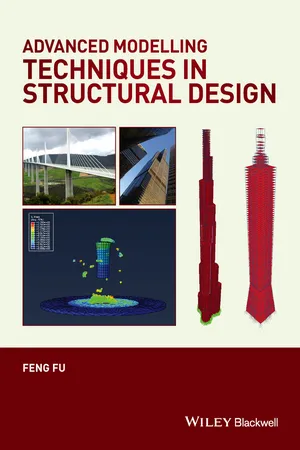1.1 Aims and scope
With the fast development of modern construction technology, major international city skylines are changing dramatically. More and more complex buildings, such as Burj Khalifa in Dubai, the Birds Nest Stadium in Beijing and the London Aquatic Centre, have been built over the past decade. As a Chartered Structural Engineer, the author has worked for several leading international consultancy companies and has worked on several prestigious projects around the world. The experience of the author demonstrates that in current design practice most of these buildings could not have been designed without the use of advanced modelling techniques. Fierce competition in the current design market also requires structural engineers to handle the increasing difficulty in designing the more complicated projects required by both clients and architects. This challenge can only be tackled by using modern computer technology. It also imposes a big change in the role of the structural engineer: in addition to knowledge of basic design principles and structural analysis methods, an engineer should also have a full understanding of the latest modelling techniques. This is also the reason that advanced computer modelling skills have recently become essential for an engineer's recruitment by increasing numbers of design consultancies.
However, in the construction industry, most structural engineers find themselves lacking modelling knowledge, as few textbooks have been provided in this area. For students, although some elementary modelling techniques are taught in most Civil Engineering courses, no systematic introduction is made, let alone how to model a real construction project in practice. Therefore, a book in this area is imperative.
The main purpose of this book is to introduce and provide detailed knowledge of advanced numerical analysis methods and important design principles for both students and design practitioners. It addresses effective modelling techniques in solving real design problems and covers a broad range of design issues – such as lateral stability of tall buildings, buckling analysis of long-span structures and earthquake design – and some special issues such as progressive collapse, blast, structural fire analysis, foot-induced vibrations and so on.
It also introduces a variety of major modelling programs (such as SAP2000, ETABS, Abaqus®1, ANSYS) and preprocessing software (Rhino, Revit, AutoCAD) used in current structural design practice. A number of modelling examples using this software are provided in the book. Most of the model examples are based on a worldwide selection of real design projects, such as the Millennium Bridge and Burj Kalifa, helping readers to find an effective way to model these types of structures.
In addition, the algorithms and theories that underpin the analysis, such as the finite element method (FEM) and smoothed particle hydrodynamics (SPH) method, are also introduced. Along with the introduction of modelling techniques, relevant design principles and design guidance are also covered. Thus this book can also serve as a handbook for structural engineers. A feature of this work is that it introduces advanced and complicated theory in a more understandable and practical way.
In real design practice, we analyse the structure with an advanced program to gain a level of confidence, such as a ball-park figure for the size of the structural members, but when we start the design we will still follow a code of practice, even though some are quite conservative. Advanced modelling is particularly complementary to current design guidance in those areas where it is still not clear. Therefore, this book will help readers understand the balance between analysis and design.
1.2 Main structural design problems
As a structural engineer, one is required to design different type of buildings such as tall buildings, bridges and space structures. Each type of structure features different structural design problems that a structural engineer needs to pay special attention to during their design. This book covers almost all the important design issues in modern construction projects. In this section, a brief introduction to these different structural problems will be given.
In tall building design, the main issue is the design of the lateral stability systems. In Chapter 3, a detailed introduction to the different lateral stability systems – such as out-triggers, tubular systems and bracing systems – will be given in addition to information on how to model them effectively.
Earthquake design is important for buildings being built in high seismic activity areas. This is covered in Chapter 4. The major earthquake analysis methods – such as response spectrum analysis, time history analysis and push-over analysis – are introduced and modelling examples in SAP2000 are also provided.
Progressive collapse has become another important issue since 911: Chapter 5 covers this topic. The design methods provided by the design guidance are introduced. Different analysis procedures, such as linear static, nonlinear static, linear dynamic and nonlinear dynamic analysis, are explained. A modelling example of nonlinear dynamic progressive collapse analysis is demonstrated using SAP2000.
Aside from conventional loading, blast and fire are other possible threats to the building and its occupants, and Chapters 6 and 7 cover these issues. How to represent these types of special loading and the corresponding design guidance are introduced. In Chapter 6 a new technique in modelling blast or impact effect, the SPH method, is introduced and a modelling example of SPH analysis using Abaqus® is demonstrated. In Chapter 7, a modelling example of heat transfer analysis of a structure is demonstrated.
For space s...
